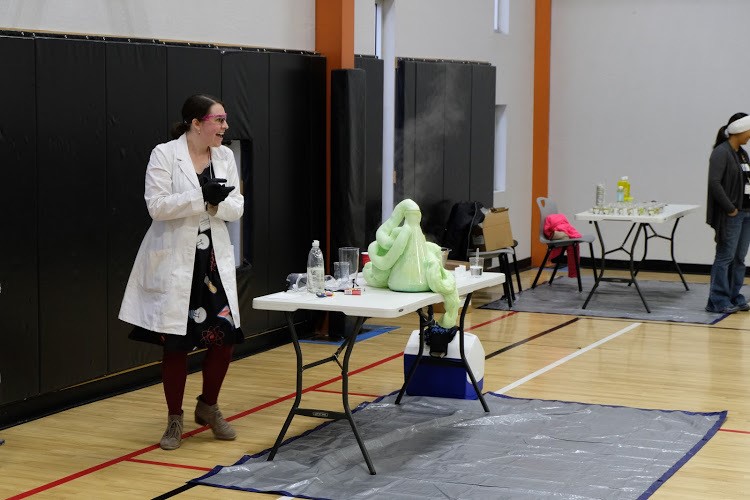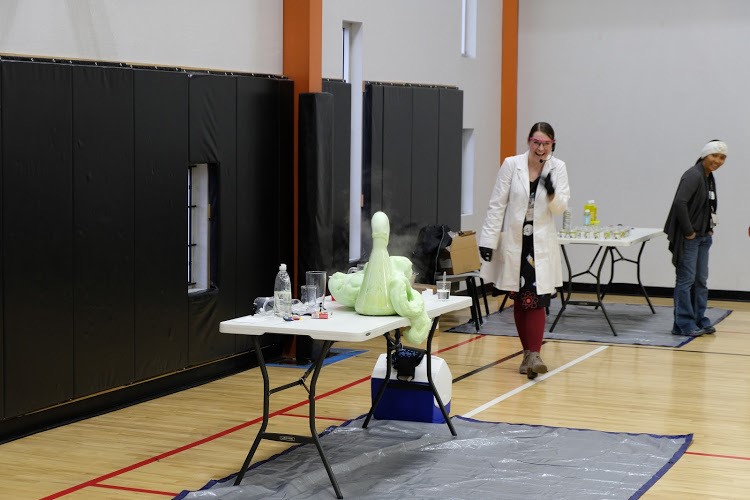Today, you can do this chemistry activity with your kids using materials you probably already have in your kitchen! We have advice about how to get started, and how to tailor this activity to children of different ages.

For more ideas about summer experiences you can do while learning at home with your kids, visit the main page, Charter a Summer of Learning.
Make Elephant Toothpaste in Your Kitchen
I love doing the Elephant Toothpaste experiment with kids. Not only is it a great example of an exothermic chemical reaction, but it is a lot of fun too! In the end, you produce a giant foamy mixture resembling toothpaste. You’ll have enough toothpaste even for elephant sized teeth! Here are some basic materials you will need.
Materials
Hydrogen Peroxide (the standard 3% works just fine, but if you have a higher percentage like what you would find at Sally Beauty, that works even better!)
Dish soap
Dry yeast
Warm water
Food coloring (optional)
Plastic bottle (dry, empty water bottle or soda bottle)
Small cup/bowl
Measuring cups
Funnel (optional)
Container/pan or plastic table covering (optional, but makes clean-up a breeze!)
Lab coat/apron/baggy old t-shirt (optional)
Procedure
Set up your experiment space. Place your container or pan on the table, or cover the table with a plastic covering. Place your dry, empty plastic bottle in your container/pan or directly on the covered table.
1. Pour ½ cup of Hydrogen Peroxide into your plastic bottle.
2. If using food coloring, add a few drops (about 5) directly to the Hydrogen Peroxide. Swirl.
3. Add a big squirt of dish soap to the plastic bottle containing the Hydrogen Peroxide. Swirl.
4. In a separate small cup/bowl, add 3 tablespoons of warm tap water.
5. Measure 1 tablespoon of dry yeast (or use 1 packet) and add the yeast to the cub/bowl containing the warm water. Stir for about 30 seconds or until it resembles the consistency of melted ice cream.
6. If using a funnel, place it on top of your plastic bottle. Carefully but quickly, pour the water/yeast mixture into the plastic bottle containing the hydrogen peroxide.
7. Observe and enjoy! Your elephant toothpaste is safe to touch if 3% Hydrogen Peroxide was used. Just make sure foamy hands stay away from mouth and eyes until after they have been washed.
8. To clean up, the Elephant Toothpaste can be washed down your kitchen sink drain with water.

Chemistry Story Time for Preschoolers
For young children, I like to start this activity with a story time. Choose a book that features an elephant—my favorites are Elmer by David McKee, Horton Hears a Who! by Dr. Seuss, and the Elephant and Piggie series by Mo Willems. Even elephants need to brush their teeth, so today we are going to do a science experiment that makes enough toothpaste for an elephant! Have your child help you measure the ingredients and pour them into the containers. After step 7 of the experiment, ask your child what they see, hear, and feel. Under supervision, allow them to enjoy playing with the foam!
Kitchen Chemistry with Grade Schoolers
For children in middle grades, encourage your child to read the materials list and collect the materials from the kitchen, similar to scavenger hunt. Have them attempt to read and follow the procedure on their own with adult oversight, though we do suggest the adult handles the Hydrogen Peroxide. In step 5, explain to your child that by mixing the yeast with the warm water, they are making a catalyst. A catalyst is a material that speeds up a reaction, which is why when the yeast/water mixture is added to the Hydrogen Peroxide in step 6, you quickly see the reaction occur in front of your eyes! After step 6, have your child feel the outside of the bottle and ask them to make an observation. What do they notice? The bottle feels warm. Reactions can be exothermic or endothermic. This reaction is exothermic, meaning it releases heat, hence the warmth you feel from the bottle!
Big Kids Like Elephant Toothpaste, Too
Teens (and adults too!) can still gain a lot from this experiment by building on their existing knowledge of chemistry. Talk to your teen about what materials they will need, and let them work through the experiment independently. Elephant toothpaste is a chemical reaction, a process in which the reactant (in this case Hydrogen Peroxide) is converted into one or more different substances. The chemical formula for Hydrogen Peroxide is H₂O₂. After completing the experiment and making observations, challenge your teen to identify the chemical reaction that occurred. You started with Hydrogen Peroxide but no longer have Hydrogen Peroxide. Have you noticed the presence of bubbles in the foam? Hint: Light a match and hold it near your foam or drop it in the foam. What do you notice? The flame burns. This suggests the presence of oxygen.
H₂O₂ —catalyst→ O₂ + ___?____
We have now proved the presence of oxygen gas, but what else was produced? We have Hydrogen atoms that we need to account for. Take a close look at your foam and you will notice it is water.
H₂O₂ —catalyst→ O₂ + H₂O
Now we see that our chemical reaction took Hydrogen Peroxide and converted it into oxygen gas and water. This is why your foam is safe to touch! Don’t forget to balance your reaction . . .
2 H₂O₂ —catalyst→ O₂ + 2 H₂O

Read More About Kitchen Chemistry
“Make Elephant Toothpaste,” Scientific American
“Fantastic Foamy Fountain,” Science BOB
“Elephant Toothpaste,” Steve Spangler Science
Information About BASIS Charter Schools
BASIS Charter Schools provide students with a rigorous liberal arts education, including a strong science curriculum. A new campus, BASIS San Antonio Northeast, is opening in August 2020. Read more about BASIS Charter Schools in San Antonio in these posts:
“BASIS San Antonio Shavano School Profile,” San Antonio Charter Moms
“BASIS San Antonio Primary Medical Center Campus School Profile,” San Antonio Charter Moms
“BASIS San Antonio Enrollment Guide,” San Antonio Charter Moms
“BASIS San Antonio Primary Offers Rigorous Education to Elementary School Students,” Inga Cotton, San Antonio Charter Moms
Charter Moms Chats
Watch Inga Cotton’s interview with Audrey Hagopian—and her assistant, Savannah—including a live demo of Elephant Toothpaste.
For more ideas about summer experiences you can do while learning at home with your kids, visit the main page, Charter a Summer of Learning.
About the Author
Audrey Hagopian is the Regional Director of Primary Schools for BASIS.ed. Formerly a 4th and 5th grade science teacher in Phoenix, Arizona, Audrey still loves sharing the wonderful world of chemistry with her community! When not stirring up experiments in her kitchen and running a school, Audrey enjoys reading, cooking, and staying sane in quarantine by hiking and mountain biking.